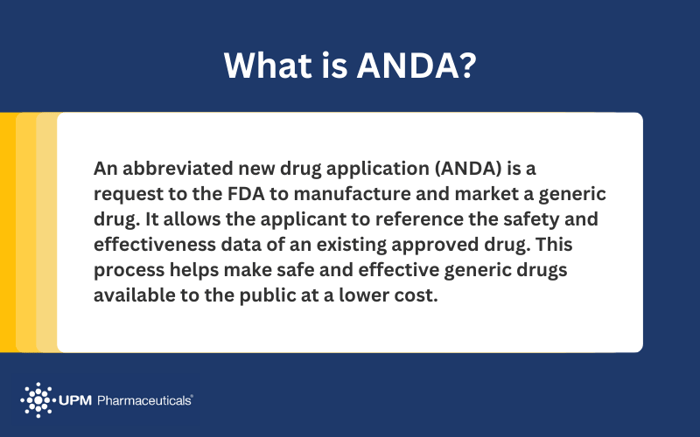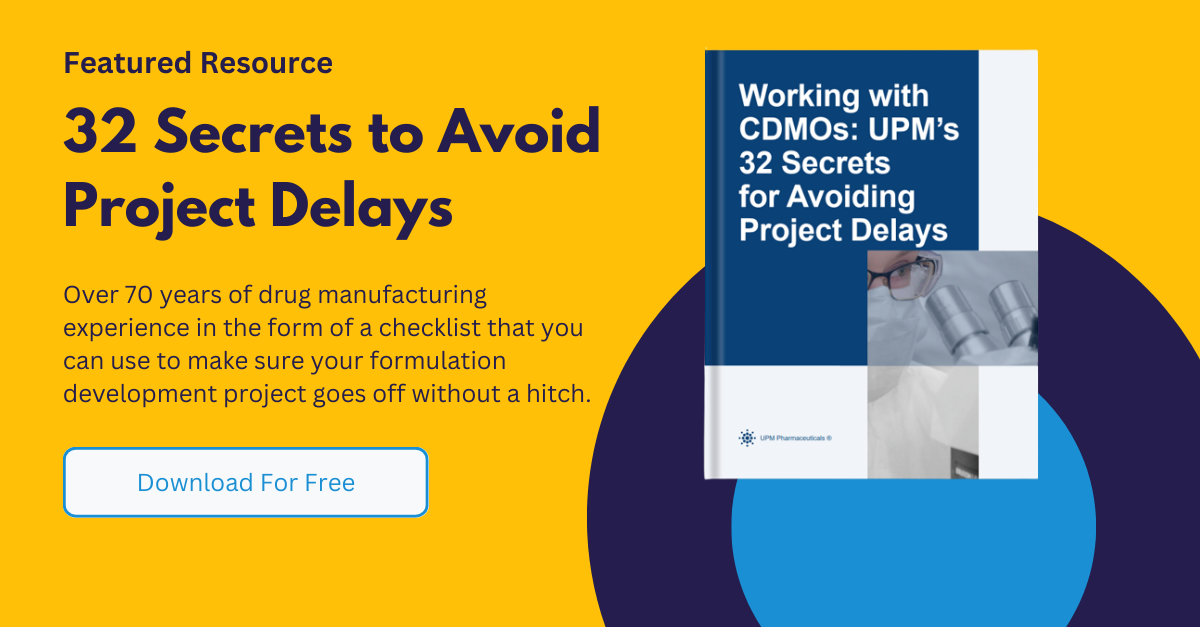An Abbreviated New Drug Application (ANDA) is a submission to the U.S. Food and Drug Administration (FDA) for the approval of a generic drug. It contains data that demonstrates the proposed generic drug is the same as an already approved drug in terms of active ingredients, dosage form, strength, route of administration, quality, and performance characteristics. Once approved, the applicant may manufacture and market the generic drug as a safe, effective, and lower-cost alternative to the brand-name drug it references. The ANDA is an essential part of the regulatory process for generic drug approval in the United States, aiming to reduce the price of drugs, decrease development time, and increase the bioavailability of the drug compared to the reference listed drug.
- The Goal of ANDA
-
How to Determine Whether to Submit an ANDA or 505(b)(2) Application
- FDA Regulations and Guidance
- FAQ
The Goal of ANDA
Inherent in the design and purpose of an Abbreviated New Drug Application (ANDA) is the goal to facilitate a more streamlined, cost-effective path to market for generic drugs, thereby enhancing the accessibility and affordability of critical medications for consumers.
Initiated with the submission of an ANDA application, the ANDA process is a regulatory pathway specifically crafted to expedite the approval of generic drugs.
By demonstrating bioequivalence to the reference listed drug, a generic drug product can bypass the time-consuming and expensive clinical trials usually required, making it a preferred ANDA pathway. This critical aspect of the ANDA submission process results in a shorter development timeline. It also ensures that the generic drugs are as safe and effective as their brand-name counterparts, providing a higher degree of freedom in healthcare choices for consumers.
The ANDA review process, under the auspices of the FDA's Generic Drug User Fee Amendments (GDUFA), further enhances the efficiency and utility of the process. It underscores the agency's commitment to fostering an environment where generic drugs can thrive, ultimately contributing to a more competitive and cost-effective pharmaceutical market.

How Do you Submit an ANDA?
Having established the purpose and benefits of the ANDA process, it is essential to understand the procedural aspects, specifically, how an Abbreviated New Drug Application is submitted to the FDA.
The process begins with adhering to the ANDA submission requirements, which mandate electronic format submissions via the FDA's Electronic Submission Gateway.
Key components include the completion of several ANDA form submissions, including Form FDA-356h and FDA-3674, which form part of the comprehensive application submissions. Each submission must be accurate, ensuring compliance with regulatory standards.
The process also involves following the ANDA submission roadmaps provided by the FDA, which outline the content, format, and evaluation guidelines. These roadmaps, along with other ANDA submission resources available on the FDA's website, offer valuable guidance for applicants.
How to Determine Whether to Submit an ANDA or 505(b)(2) Application
Deciding whether to submit an Abbreviated New Drug Application (ANDA) or a 505(b)(2) application requires careful consideration of various factors, including the unique characteristics of the proposed product and the types of studies, data, and information necessary to support the application.
The choice largely depends on whether the product is a generic equivalent to a brand-name drug or a new formulation of an existing drug. An ANDA applicant seeking approval for generic drug applications must demonstrate therapeutic equivalence to an approved brand-name drug, in line with the pathway for drug approval outlined under the Hatch-Waxman Act.
On the other hand, a 505(b)(2) application may be appropriate for new formulations of existing drugs that differ in dosage form, route of administration, or strength from the reference drug. This application requires more extensive data and may require additional clinical studies to establish safety and efficacy.
The regulatory requirements for these two types of applications differ significantly, making it crucial for applicants to understand the necessary steps for each ANDA submission. Careful consideration and possibly consultation with regulatory experts can assist in the decision-making process, ensuring compliance and enhancing the likelihood of approval.
Resources for ANDA Submissions
After determining the appropriate regulatory pathway for a proposed drug, either ANDA or 505(b)(2), the next crucial step is to navigate the complexities of the submission process, which involves a range of resources designed to assist applicants in meeting the requirements.
To facilitate the ANDA forms submission requirements, the FDA provides a series of resources that guide applicants through the generic drug approval process.
- The FDA's website offers detailed guidance on the ANDA process, including forms and submission requirements. This resource is invaluable for understanding the generic drug development and approval process.
- The FDA's Electronic Submissions Gateway (ESG) is the preferred method for all regulatory submissions, including ANDAs. This electronic submission system streamlines the submission and review process, making it more efficient and manageable.
- Consulting firms specializing in FDA regulations and the generic product approval process can offer expert advice and guidance. These professionals have extensive experience navigating the review process and can provide crucial assistance in preparing a successful submission.
These resources can significantly reduce the complexity and uncertainty associated with ANDA submissions, thereby creating a more accessible pathway to generic drug approval
FAQ
What is the purpose of ANDA?
The purpose of ANDA is to break down complex tasks into intermediate steps, aiding in understanding language structure and meaning, which is essential for chatbots and other NLP applications. This approach allows for a more accurate and contextually aware response, contributing to the development of advanced NLP and AI communication.
What is the difference between NDA and ANDA?
The difference between NDA and ANDA is that an NDA is for new drugs, while an ANDA is for generic drugs, both requiring different levels of evidence and testing. NDA is for new drugs, ANDA is for generics, each with distinct evidence and testing requirements.
How long does it take for ANDA to be approved?
ANDA approval, mandated by the FDA within 180 days per federal law, generally takes around 30 months for review. The FDA may expedite reviews for drugs addressing severe conditions or public health concerns. Approval timing varies based on drug complexity.
What is required to get a generic drug approved under an ANDA?
For ANDA approval, generic drug applicants must demonstrate bioequivalence to the reference-listed drug (RLD) in safety, efficacy, and quality. Details on active ingredients, usage conditions, administration, form, potency, and labeling, along with evidence of bioavailability, are crucial. Unlike new drugs, ANDAs don't require preclinical or clinical trial data, relying on the FDA's prior approval of the RLD for safety and effectiveness. The ANDA process aims to boost competition and reduce prescription drug costs.
Download Now: 32 Secrets to Avoid Project Delays [Free eBook]
CONTACT US
Partner with a Qualified CDMO: UPM Pharmaceuticals
Bringing a new drug to market is a lengthy, costly, and risky journey, compounded with the time pressure of being first in the marketplace. UPM is unlike other CDMOs because we are a large pharma supplier and an independent, family-owned CDMO, allowing us greater flexibility in our partnerships. To this point, our ended-to-end CDMO services have helped bring over 80 pharma products to market.
Our state-of-the-art seven-acre pharmaceutical campus features our commercial manufacturing and packaging site, commercial warehouse, and DEA-Approved vault. With extensive pharmaceutical industry experience and a solid track record of bringing drug products to market, our capabilities are the best that commercial pharma has to offer. Contact UPM to learn more about our contract development and manufacturing organization and how we can optimize your pharmaceutical project results.
Connect with Our CDMO Services

